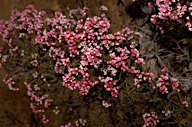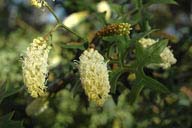

 |
Australian National Botanic Gardens |
 |
A weekly news sheet prepared by a Gardens' volunteer.
Numbers in square brackets [ ] refer to garden bed Sections.
Plants in flower are in bold type.
03 October 2008
 |
Micromyrtus ciliata - click for larger image |
Immediately to the right of the Visitors Information Centre door is a lovely pot of Sturt’s Desert Pea, Swainsona formosa, with its brilliant red and black flowers. Hanging over the path on the left is the vine Hardenbergia violacea [Section 210] with showy purple flowers. Even higher on the left are more purple blooms, this time Alyogyne ‘West Coast Gem’ [Section 210]. Further along on the left are the bright yellow flowers of the scrambling Hibbertia empetrifolia [Section 210]. At the end of the walk on the right is a pretty Grevillea ‘Little Jessie’ [Section 174] with soft pink spider blooms with red styles. Bear left past the Rainforest Gully sign up the hill to see the smothering groundcover Grevillea ‘Poorinda Royal Mantle’ [Section 124] showing off its multitude of red toothbrush flowers.
On the right is a large shrub Grevillea ‘Poorinda Diadem’ [Section 126] covered in golden flowers. Bear left up the hill, right through the green pylons to the low growing Micromyrtus ciliata [Section 9] with masses of small white flowers on arching branches changing to deep pink as they age. Also on the left is the striking contrast of grey foliage and red flowers of Calothamnus quadrifidus [Section 9] or Common Netbush. Sit on the bench dedicated to the memory of Tom Green and watch the birds bathe in the soak opposite. Olearia viscidula [Section 29] is a huge shrub covered in small bunches of white daisy flowers. Bear left up the hill towards the Sydney Region Gully past Philotheca ‘Poorinda’ [Section 112] on the left showing a mass display of white flowers and pink buds. Also on the left is Phebalium squamulosum [Section 112] covered in fluffy yellow flowers.
As you proceed up the Sydney Region Gully at the half-moon bump-out is the soft mauve flowers and tiny scale like foliage of Prostanthera rugosa [Section 191J]. Turn right towards the Display Glasshouse and notice on the left the huge bud of the Gymea Lily Doryanthes excelsa [Section 191D ] and close to it Isopogon dawsonii [Section 191D] with its pine like foliage and grey/cream pincushion flowers. Turn right down the narrow path on the other side of the gully to see overhead the bright gold flowers of Pultenaea flexilis [Section 191 K]. Close by are the lime green sickle buds and ash grey foliage of Acacia bulgaensis [Section 191K] or Bulga Wattle. As you pop out of the Sydney Region Gully on the left is a beautiful Boronia pinnata [Section 191K] with soft pink blooms.
 |
Grevillea flexuosa - click for larger image |
Turn right and follow the Main Path down to the left where there is a large bush of Grevillea flexuosa [Section 26] with its cream, sweetly scented rods. Further on the left are the stoplight red cupped blooms of the Waratah or Telopea speciosissima [Section 26] showing up boldly. Also on the left is the well-named Spindly Grevillea or Grevillea endlicheriana [Section 26] with white puffball flowers on long stems. On the right are several large bushes of Grevillea ‘Bonfire’ [Section 24] with red waxy spider flowers. Also on the left is a honey-scented bush of Grevillea australis ‘Cara Lynn’ [Section 24] with small tightly curled white flowers. Now follow the Main Path back to the restful Café.
Rosalind Walcott